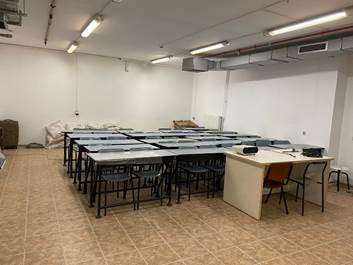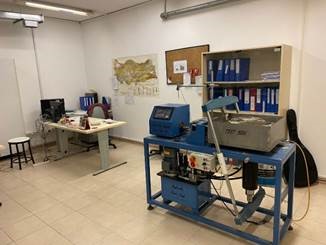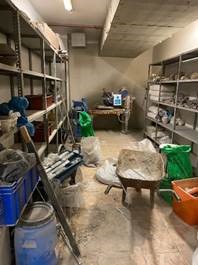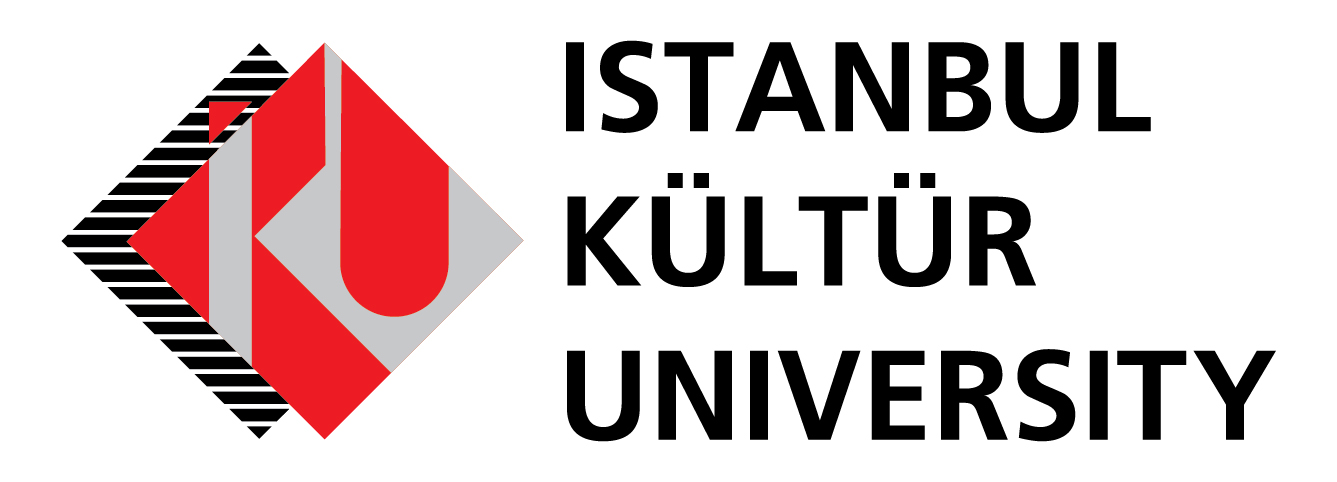The Geotechnical Laboratory was established in 2001 to enable civil engineering undergraduate students to conduct experiments related to the content of soil mechanics courses. It is still actively providing service. The laboratory has a wide infrastructure that allows many tests to be carried out on soil and rock for undergraduate, thesis-based master's, and doctoral research studies. The laboratory is divided into sections for sample preparation and conducting experiments on the prepared samples.
For this purpose, the laboratory consists of a total of five rooms:
-
A classroom with a capacity of 30 people where courses are conducted,
-
A large entrance area of 82 m² where test samples are prepared,
-
A separate room of 28 m² where test results are evaluated,
-
A room of 18 m² where rock samples are displayed, rock specimens are cut, and samples are ground,
-
A room of 30 m² where soil tests are conducted.
-
In the 82 m² entrance area where test samples are prepared, there are two large marble workbenches that allow the preparation of soil samples for testing. Preliminary preparations required for bringing samples to the standard dimensions specified in test procedures are carried out in this area.
The equipment available includes:-
Sieve sets and automatic shaking sieve system used in sieve analysis experiments for determining soil classification,
-
Mixer and beakers for hydrometer analysis,
-
Vacuum pump used for specific gravity tests,
-
Casagrande and falling cone devices used in liquid limit tests,
-
Standard and modified compaction (Proctor) molds and rammers for compacting the soil,
-
Sample tubes, rings, and sample extruders required for strength and settlement tests,
-
Four balances with different precision and capacity for weighing test samples,
-
Two ovens for drying test samples.
Since distilled water is required in all experiments, two water distillers are also available.
-
In addition, the lab contains numerous test devices used in soil and rock experiments, including:
-
12-liter Alex ultrasonic bath device (acquired through R&D),
-
Drying shrinkage test device,
-
Rock crack cutting apparatus,
-
Abraham cone,
-
Two direct-residual shear devices (manual and digital),
-
Rock triaxial cell pump/solid press unit,
-
Brazilian splitting test device,
-
Point load test device,
-
Aggregate impact test device,
-
Falling and constant head permeability test systems,
-
Core drilling machine,
-
Vibrating compaction hammer,
-
Pocket penetrometer,
-
Strain gauges, and more.
-
In the classroom with a capacity of 30 people, undergraduate, graduate, and doctoral courses are held. Education is provided to students using a projector and whiteboard, in a classroom environment with appropriate lighting and temperature for lecture delivery.
-
In the 18 m² room where rock samples are displayed and where rock specimens are cut and ground, igneous, metamorphic, and sedimentary rocks are exhibited.
Also, equipment acquired through R&D includes a jaw crusher, stone cutting machine, and cross beater mill.
Rock specimens are cut to testable dimensions using the stone cutting device, and the jaw crusher and cross beater mill are used to grind the material to the desired size.
-
In the 30 m² room where soil tests are conducted, strength tests are performed.
Equipment available in this section includes:-
Digital triaxial compression device,
-
Manual unconfined compression device,
-
Multiplex universal test frames,
-
Load rings,
-
Pore pressure, axial deformation, and length transducers,
-
Constant pressure systems,
-
Volume gauges,
-
Data acquisition and recording systems,
-
Additionally, an automatic Geocomp brand direct shear device for shear box tests,
-
Consolidation test devices for evaluating settlement behavior.
-
-
In the 28 m² room where test results are evaluated, there is a large-scale shear box, Bromhead shear test device (acquired through R&D), and one computer and a printer used for evaluating test results.
The Civil Engineering Geotechnical Laboratory has a total of four computers, all of which are connected to the internet for data collection during tests.
Tests Conducted in the Laboratory:
-
To determine soil classification: classification tests (sieve analysis, hydrometer analysis, specific gravity, Atterberg limits),
-
To determine the amount of water passing through soil: permeability tests (falling head and constant head),
-
To determine the relationship between optimum water content and maximum dry unit weight of soil: compaction tests (standard and modified Proctor),
-
To determine soil strength parameters: triaxial compression tests (UU, CU, CD), unconfined compression, and direct shear box tests,
-
To determine settlement behavior: consolidation tests,
-
For rock: triaxial compression test, unconfined compression, Brazilian splitting test, shear test, point load test, and porosity measurement can be conducted.

Classroom with 30-person capacity

Large entrance area (82 m²) for sample preparation

Room for evaluating test results (28 m²)

Room for displaying rock samples and cutting/grinding rock specimens (18 m²)

Room for conducting soil tests (30 m²)


